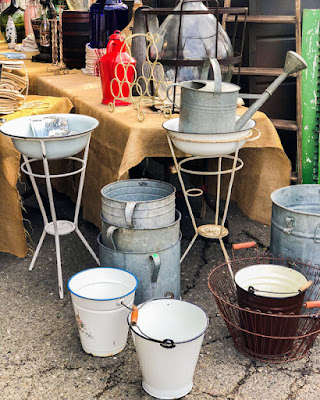
Popular event to be held in arena parking lot Sunday

|
|
Shoppers can find all kinds of fun containers,
tools and other items for the garden at the relocated Sac Antique Faire. (Photo courtesy Sacramento Antique Faire) |
It’s in a new location and, this month, a different day, but the Sacramento Antique Faire has long been a wonderful place for finding potential garden art, planting containers, used tools and decorations.
Packed with (mostly old) treasures of all kinds, the Sac Antique Faire will fill the parking lot of the old Sleep Train Arena from 6:30 a.m. to 3 p.m Sunday, Oct. 17. Admission is $3 (cash only); youth under age 16 admitted free. Parking is free.
The event uses the arena’s East Entrance parking booths as its admission gates. Enter using the Truxel Road gate.
“Admission is paid from your vehicle through a toll booth when arriving at the Faire,” says its website. Cash only keeps the cars moving.
Although this is an outdoor event, patrons are encouraged to wear face masks and social distance when possible.
For decades, the Faire was held under the “W-X Freeway,” that section of Interstate 80/50 that runs through Downtown and Midtown Sacramento. But construction work on that freeway forced the relocation of the monthly antiques market as well as the popular Sunday farmers market.
This fall, the Faire has made itself at home at the arena. The parking lots have plenty of room for more than 300 vendors plus many shoppers.
“All items must be antiques and/or collectibles,” according to the organizers. “The collectibles must be 20 years old or older. We do not sell crafted or newly manufactured goods at our Faire.”
That said, wear comfortable walking shoes; there will be a lot to browse!
Usually, the Faire is held on the second Sunday of each month; October’s event is an exception. The Faire will return to its usual day in November. Remaining 2021 dates are Nov. 14 and Dec. 12.
Those dates also will be held at Sleep Train Arena, 1 Sports Parkway, Sacramento.
Details and directions: www.sacantiquefaire.com .
Comments
0 comments have been posted.Sacramento Digs Gardening to your inbox.
Food in My Back Yard Series
May 6: Maintain soil moisture with mulch for garden success
April 29: What's (already) wrong with my tomato plants?
April 22: Should you stock up on fertilizer? (Yes!)
April 15: Grow culinary herbs in containers
April 8: When to plant summer vegetables
April 1: Don't be fooled by these garden myths
March 25: Fertilizer tips: How to 'feed' your vegetables for healthy growth
March 18: Time to give vegetable seedlings some more space
March 11: Ways to win the fight against weeds
March 4: Potatoes from the garden
Feb. 25: Plant a fruit tree now -- for later
Feb. 18: How to squeeze more food into less space
Feb. 11: When to plant? Consider staggering your transplants
Feb. 4: Starting in seed starting
Sites We Like
Garden Checklist for week of May 4
Enjoy this spring weather – and get gardening!
* Plant, plant, plant! It’s prime planting season in the Sacramento area. Time to set out those tomato transplants along with peppers and eggplants. Pinch off any flowers on new transplants to make them concentrate on establishing roots instead of setting premature fruit.
* Direct-seed melons, cucumbers, summer squash, corn, radishes, pumpkins and annual herbs such as basil.
* Harvest cabbage, lettuce, peas and green onions.
* In the flower garden, direct-seed sunflowers, cosmos, salvia, zinnias, marigolds, celosia and asters. (You also can transplant seedlings for many of the same flowers.)
* Plant dahlia tubers. Other perennials to set out include verbena, coreopsis, coneflower and astilbe.
* Transplant petunias, marigolds and perennial flowers such as astilbe, columbine, coneflowers, coreopsis, dahlias, rudbeckia and verbena.
* Keep an eye out for slugs, snails, earwigs and aphids that want to dine on tender new growth.
* Feed summer bloomers with a balanced fertilizer.
* For continued bloom, cut off spent flowers on roses as well as other flowering plants.
* Add mulch to the garden to maintain moisture. Mulch also cuts down on weeds. But don’t let it mound around the stems or trunks of trees or shrubs. Leave about a 6-inch to 1-foot circle to avoid crown rot or other problems.